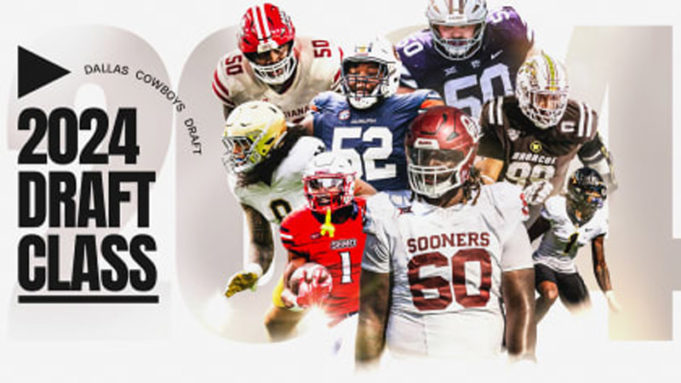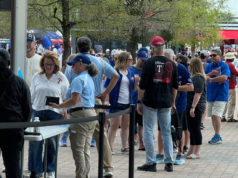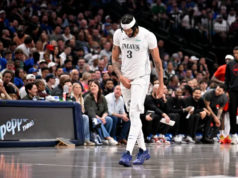In front of the 750,000 in attendance in Detroit and more than 34 million TV viewers around the world, the NFL flexed its pythonic sports-dominating muscles last week and demonstrated just what an insane spectacle the league can make out of simply sorting a new class of rookies. While my poor spouse (God bless her) — along with just about any other relatively sane individual — certainly can’t understand why, I mainlined nearly every single minute of the 17 hours of coverage spread over the three long days of the event, mostly because I am a highly flawed and obsessive person but also so you, dear reader, didn’t have to. Naturally, considering my unhealthy preoccupation with professional football in general, and the Dallas Cowboys specifically, I have thoughts.
If there’s been a theme developing around the Cowboys’ frustrating offseason approach in this foul year of our lord 2024, it has become personified by Jerry Jones’ contradictory use of the words “all in” to describe it. Considering the front office’s painfully frugal “roster-building” process over the last few months, the expression is now practically Orwellian double-speak, rivalling phrases like “Patriot Act” and “right to work.” Just as the disappointment of watching the front office dip but a sliver of a hangnail into the free agency waters had begun to subside and disgruntled fans were moving on from the idiom, the owner/GM/word-salad dispenser reopened the wound. Quite trollingly, he let “all in” dribble out of his highly cosmetically enhanced face during the team’s post-draft press conference on Sunday. Repeatedly. Like a mantra. Now “all in” has become this franchise’s misguided “Mission Accomplished” banner hanging behind its feckless figurehead.
It’s not hard to see Jones’ shortsighted exclamations as lip service at best and as intentional deception akin to historic shyster Clark Stanley’s infamous trade in emulsions of serpentine origin at worst, but the owner’s tone-deaf carnival barking is no less galling.
If there’s an actual methodology to the brass’ offseason approach, it’s certainly not the one they’re selling. The front office seems much more focused on 2025 than 2024. They seem perfectly content to chalk up the coming season as a write-off and look to enter next year with potentially an entirely new coaching staff, a new starting quarterback, and a giant pile of unallocated salary cap money.
The previous weeks have seen a staggering eight starting players from last year’s roster lost to free agency, with only one of them replaced by the same. That is, unless you’re buying more of Jerry’s snake oil and believe the return of a certain spoon-miming running back who averaged just three yards a carry last season in New England now makes it two. The complete refusal of this organization to seek outside reinforcements ensured that this past weekend’s draft would be the only way Dallas might be able to field a complete NFL team come September.
With limited draft resources, they fell well short of even that meager goal. As is often the case when one paints themselves into a corner, you inevitably step into the color. There’s quite a lot to like in this year’s player haul, but with the massive gaps on the roster, painted footprints are tracked all around the house, leading to the inevitable conclusion that this team is looking ahead to 2025 and beyond. The picks seem to prove the point.
Entering the first round last Thursday, Dallas had two goals in mind: Come away with a plug-and-play offensive lineman and another pick in the Top 100. They got pretty close to succeeding. By dropping from their pick at 24 to 29 in a trade with the Lions, the Cowboys gained Detroit’s third-round pick at 73. That’s a massive overpay for Coach Dan Campbell’s team, but that’s the type of move that an organization that is really going “all in” makes. At 29, the Cowboys selected Oklahoma offensive tackle Tyler Guyton. This raw, athletic 6’8”/328-lb. monster has a big upside, but with only 14 starts in college and just 70 of his 1,100 career snaps at left tackle, it’s a big ask that he immediately step into the position occupied by future Hall of Famer Tyron Smith for the last 13 years.
Speaking of big asks, Dallas used the pick from Detroit at 73 to take another high-upside offensive lineman in Kansas State’s Cooper Beebe. An absolute steal in the third, the two-time Big 12 Offensive Lineman of the Year is an absolute mauler and projects to replace departed center Tyler Biadasz. Thing is, while he played four of the five positions along the O-line in college, Beebe has never played center. My gut tells me this pick is really intended to eventually replace another Hall of Fame lineman, right guard Zack Martin, when he inevitably splits next year.
Between the O-line picks, Dallas took defensive end Marshawn Kneeland out of Western Michigan in the second round. With the Panthers swiping the prize the Cowboys were really eying in this round, Texas RB Jonathon Brooks, Kneeland is decent value at 56, considering many thought he could sneak into the back end of the first round. He should slot in as a rotational defensive lineman with a focus on run stuffing, a strikingly similar skill to Demarcus Lawrence, another tenured Cowboy on the last year of his contract. Convenient, eh?
With their pick at 87, Jerry and Co. had their lone whiff. With a run at linebacker — a drastic need — ticking off the board in front of them, the ’Boys panicked and took Notre Dame’s Marist Liufau. I don’t mind the player. He’s a violent, hair-on-fire, heat-seeking missile of an LB, but his instincts are lacking and his eagerness to blow up guys leads to some over-pursuit and blown assignments. Would have loved the selection if Dallas had been able to trade back again into the fourth round, maybe snagging an early fifth in return, and taken Liufau there (where most draftnicks predicted he’d go) while grabbing a potential starting RB if available in the fourth.
Sadly, that was not to be. Dallas entered a draft desert after the Liufau pick, watching 87 quality players fall off the board before being able to pick again late in the fifth. And with that choice (174 overall), they selected Wake Forest corner Caelen Carson. Current slot corner Jourdan Lewis is — you guessed it — also on an expiring deal, and there’s no doubt that the Joneses hope Carson (or another of the depth corners currently on the roster) replaces him next year. Until then, Carson will get most of his playing time on special teams.
We had three more picks between the sixth and seventh rounds, when depth and traits-based dart throws are really all that is available. We took an athletic wide receiver in Southeast Missouri State’s Ryan Flournoy (216); more O-line depth with Nathan Thomas, a tackle out of Louisiana Lafayette (233); and a 1-tech in Auburn’s Justin Rogers, none of them expected to make much of an impact in 2024.
Considering our limited resources, the future looks bright with this year’s draft haul. Taken at face value, the class is probably a solid B+, but when judging by the context of what it means for this coming season, with key starting positions like RB, WR, and possibly even center still huge question marks going into next season, it’s a big fat D for Big D. Buckle up, Cowboy fans. 2024 could be a long year.












